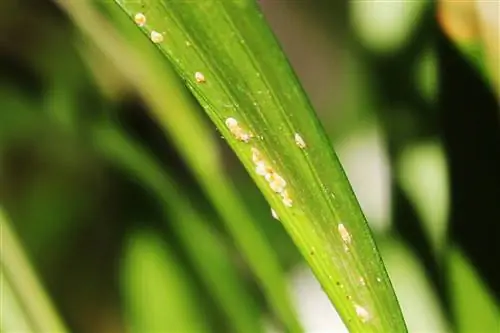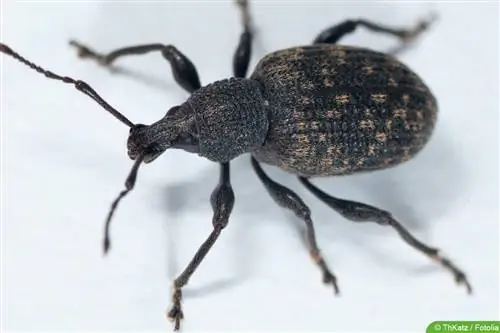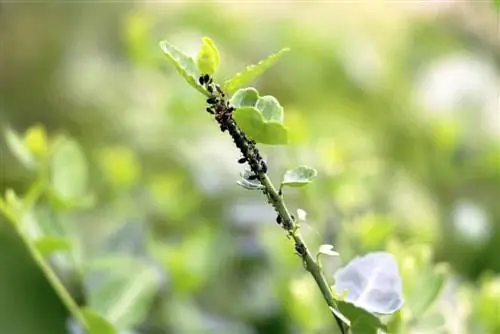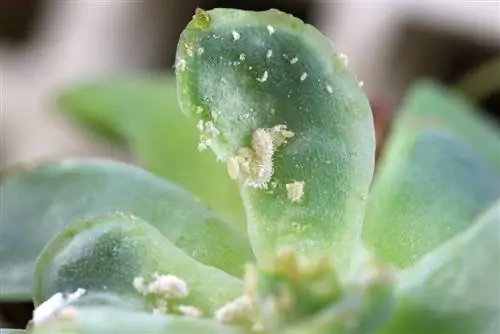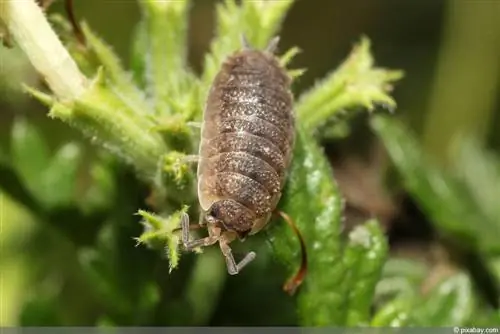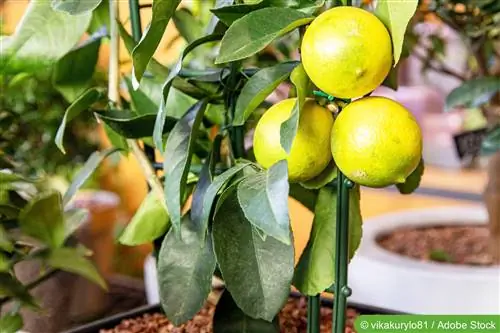- Author admin [email protected].
- Public 2023-12-17 03:39.
- Last modified 2025-01-24 12:45.
Scale insects not only cause a lot of damage, but are also particularly stubborn. That's why you should fight the insects immediately. If you wait, the entire plant will soon be covered in plant lice.
Scale insects (Coccoidea)
Scale insects are plant lice (Sternorrhyncha). Of the 3,000 species known to date, around 90 live in Central Europe. Since they feed on plant sap, they are pests for the gardener. The size of the insects is between 0.8 and 6 millimeters. Therefore, they are often perceived by the naked eye not as animals, but as brown dots.
This impression is created by the shield that protects the mostly immobile females. But it also serves as protection for the eggs, which are laid beneath the shield shell. The larvae hatch from these, spread over the host plant, develop into females and in turn provide offspring. Males are not necessarily necessary for this, as scale insects can reproduce through so-called parthenogenesis.
malicious image
In addition to the “brown dots” mentioned, the infestation can also be recognized by the so-called honeydew. This is a sticky, clear coating that the animals excrete. Because it contains sugar, it attracts other insects such as ants and wasps.
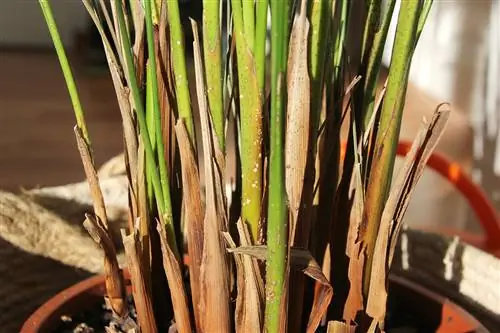
Sooty mold fungus can also form. Since it feeds on honeydew, it is not considered a parasite. However, its greyish-black coating can restrict the plants' photosynthesis, which in turn damages them.
Shower off
Showering an infected plant is often recommended. However, the effectiveness of this home remedy is questionable because it can cause the scale insect eggs to spread. That's why you should have the houseplant
- upside down if possible
- shower with a strong jet
Tip:
The effectiveness of showering is controversial for animals that are already stuck because the water jet is too weak.
Collect
This method is laborious, but promising if all lice are discovered and collected:
- collect with a sharp knife or tweezers
- don't scratch it off under any circumstances
- Clean the tool in between or soak it in alcohol
Brushing
A toothbrush dipped in soapy water is best for brushing off plant lice. With this you can also reach specimens that are in hard-to-reach places on the plant.
Home remedies
Alum (potassium aluminum sulfate)
- Mix 100 grams of alum powder with half a liter of warm water
- Dilute the mixture with four liters of water shortly before use
- apply to the scale insects with a cotton swab
- use daily
- Do not wet plant parts
Nicotine
Nicotine promises successful control of plant lice, but should no longer be used today due to its toxicity.
- Pour one liter of hot water over 150 to 200 grams of tobacco
- let it steep for one hour in a sealed container
- Paint scale insects
- dab preferred shoots thoroughly
- spray insensitive plants
- Repeat treatment every two days
Rapeseed oil
- remove visible scale insects
- brush affected areas
Olive or paraffin oil
- Coat plant lice with a thin layer of oil twice a day for two weeks
- Combine treatment with other home remedies
Tea tree oil
Apply the oil to the plant lice's shell daily with a cotton swab. Be careful not to drizzle the leaves as the harsh tea tree oil can harm the plant.
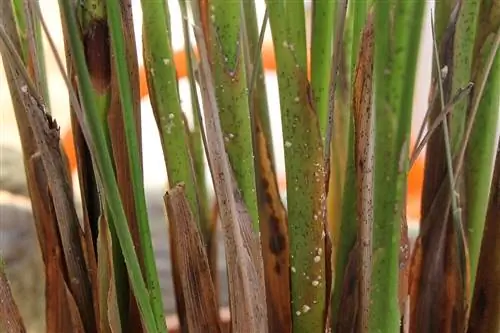
Mixtures for spraying
Curd soap-spirit-water mixture
- one liter of water with 15 milliliters each of liquid soap and denatured alcohol
- Let it steep for 30 minutes
- Spray, brush on or wipe the affected parts of the plant with a cloth
- repeat regularly over a longer period of time
- alternatively: brush plant lice with a cotton swab
Note:
Before you use the curd soap and spirit mixture, you should try it on a leaf, as not all plants can tolerate this home remedy.
Alcohol-water mixture
- mix three parts water with one part high-percentage alcohol (alternatively: spirit)
- apply to the plant lice with a cotton swab
- destroys the protective shell, leading to the death of the pests
Dishwashing liquid-vinegar-water mixture
- mix some dish soap with water and vinegar
- Spray plant
- leave it on for a few hours
- Shower off the growth
Spraying liquids
Stinging Nettle
- Place 500 grams of crushed nettle in a container with five liters of hot water
- let it rest for three days with the lid closed
- stir occasionally with a wooden stick
- filter finished brew
- Spray the plant and scale insects once a week
Alternative:
- 200 grams of fresh or 20 grams of dried nettle leaves
- shredding
- pour cold water over it
- Seal the container airtight
- let it steep for eight hours
- strain
- apply
Note:
Since nettle brew develops an extremely pungent smell, preparation and use should only take place in the garden.
Fernwort
- Pour one liter of boiling water over 100 grams of fresh or 10 grams of dried fern
- dilute with ten liters of water shortly before use
- Spray the plant extensively
- repeat weekly
Nasturtium
- Add 200 grams of nasturtiums to one liter of boiling water
- boil for a few minutes
- Let it steep for 30 minutes
- strain
- dilute with two liters of water shortly before use
- Spray the plant weekly over a large area
garlic
- Pour 1.5 liters of boiling water over 50 grams of chopped garlic
- Let it steep for 30 minutes
- strain and let cool
- Spray plant
Tip:
If the infestation is small, sticking garlic cloves into the ground can help.
Soda
- Dissolve half a teaspoon of baking soda in a liter of water
- Spray plant
Tip:
The effect of this home remedy is increased if you add a splash of alcohol or vegetable oil.
Oregano
- Pour 100 grams of fresh or 10 grams of dried oregano with one liter of boiling water
- Let it steep for 15 to 20 minutes
- screening
- dilute with three liters of water
- Use sprays weekly
tansy
- Chop 150 grams of fresh tansy
- put in a large container
- pour five liters of hot water
- let it steep for about ten minutes
- strain and let cool
- Spray the plant generously
- at least three times a week
Wormwood
- Pour five liters of boiling water over 150 grams of fresh, crushed vermouth
- Let it steep for 30 minutes
- strain
- Spray the plant with the cooled brew
Onion
- Divide the onion into smaller pieces
- boil in water
- cover and let it steep on a low heat for about 25 minutes
- strain after cooling
- Spray the plant well

